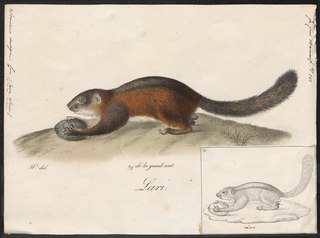
The macaques constitute a genus (Macaca) of gregarious Old World monkeys of the subfamily Cercopithecinae. The 23 species of macaques inhabit ranges throughout Asia, North Africa, and Europe. Macaques are principally frugivorous, although their diet also includes seeds, leaves, flowers, and tree bark. Some species such as the long-tailed macaque will supplement their diets with small amounts of meat from shellfish, insects, and small mammals. On average, a southern pig-tailed macaque in Malaysia eats about 70 large rats each year. All macaque social groups are arranged around dominant matriarchs.

The long-beaked echidnas make up one of the two extant genera of echidnas: there are three extant species, all living in New Guinea. They are medium-sized, solitary mammals covered with coarse hair and spines made of keratin. They have short, strong limbs with large claws, and are powerful diggers. They forage in leaf litter on the forest floor, eating earthworms and insects.

Striped ground squirrels form a taxon of squirrels under the subfamily Callosciurinae. They are only found in Southeast Asia. Species in this genus include:

The São Tomé shrew is a white-toothed shrew about 3.0 in (7.6 cm) long found only on São Tomé Island, São Tomé and Príncipe. It is listed as a critically endangered species due to habitat loss and a restricted range. It was discovered in 1886. The population continues to decrease, making these animals rare. It is found only on São Tomé Island, a small island that is actually a shield volcano that rises out of the Atlantic Ocean.

Eisentraut's mouse shrew is a Myosoricinae shrew found only on the island of Bioko, Equatorial Guinea. It is listed as a critically endangered species due to habitat loss and a restricted range.

The Sumatran water shrew is a red-toothed shrew found only in the Padang highlands of western Sumatra, Indonesia. Its natural habitats are streams in montane forests. The species is only known from a holotype, which is damaged, and was previously listed as critically endangered by IUCN. It is believed to be severely threatened by habitat loss.

A species that is extinct in the wild (EW) is one that has been categorized by the International Union for Conservation of Nature as only consisting of living members kept in captivity or as a naturalized population outside its historic range. Classification requires exhaustive surveys conducted within the species' known habitat with consideration given to seasonality, time of day, and life cycle. Once a species is classified as EW, the only way for it to be downgraded is through reintroduction.

Gerbillurus is a genus of rodent in the family Muridae. It contains the following species:
The Namib brush-tailed gerbil or Setzer's hairy-footed gerbil is a species of rodent endemic to Angola and Namibia. Its natural habitats are sandy and gravelly plains. It stays in its burrow by day, emerging at night to feed on arthropods, vegetable matter, and seeds.
The delectable soft-furred mouse or East African praomys is a species of rodent in the family Muridae. It is the only member of the genus Montemys; it was formerly classified in the genus Praomys.
The Cameroon soft-furred mouse or Cameroon praomys is a species of rodent in the family Muridae. It is found in Cameroon and Equatorial Guinea. Its natural habitat is subtropical or tropical moist montane forests. It is threatened by habitat loss.

The charming thicket rat is a species of rodent in the family Muridae. It is described as data deficient as Thamnomys schoutedeni. It is found in Democratic Republic of the Congo, Rwanda, and Uganda. Its natural habitat is subtropical or tropical moist montane forests. It is threatened by habitat loss.

The wood sprite gracile opossum is a mammal. It is a species of opossum in the family Didelphidae. It is found in Colombia and Venezuela. Its natural habitat is subtropical or tropical moist lowland forests. It is threatened by habitat loss.

The small dorcopsis or lesser forest wallaby is a species of marsupial in the family Macropodidae. It is found in the mountainous interior of West Papua and Papua New Guinea. Its natural habitat is subtropical or tropical dry forests. It is less common than it used to be and the IUCN has assessed it as being "near threatened".

Brown's pademelon is a species of marsupial in the family Macropodidae. It is found in New Guinea. Its natural habitats are subtropical or tropical dry forests, dry savanna, subtropical or tropical dry shrubland, and subtropical or tropical dry lowland grassland. It is threatened by habitat loss.
Bat Conservation International (BCI) is an international nongovernmental organization working to conserve bats and their habitats through conservation, education, and research efforts.










